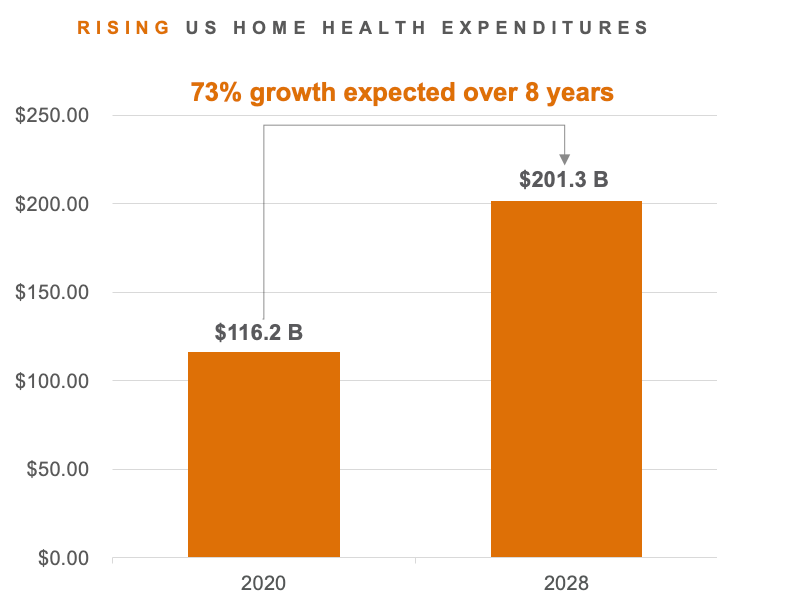
Getty Images
How Home Health Will Evolve in the Year Ahead
Changes in care delivery and strategic shifts to drive affordable, whole-person care will be important trends in home healthcare in 2022.
Healthcare is continuing to go home. The trend of moving care from the hospital to the patient’s home began in the 1990s and has been gathering steam ever since. In fact, according to the Centers for Medicare & Medicaid Services (CMS), home care expenditures are expected to reach $201B by 2028, a 73% increase from 2020.
At myNEXUS, we manage home-based care for 3M+ members of our country’s three largest health plans. We monitor current practices, trends, and market data to help our health plan clients innovate in this rapidly growing area of care. We have identified some key home care trends heading into the new year and have broken them into two categories: changes in care delivery and strategic shifts to drive affordable, whole-person care.
Care delivery changes
Shrinking the healthcare workforce: The American Hospital Association (AHA) cites that burnout, drops in long-term employment, inadequate relief resources, and declines in treatment success rates have led to a massive change in the healthcare workforce and will continue to exacerbate the care accessibility challenges nationwide. In home care, an under-managed network and a lack of qualified providers may put some vulnerable members at greater risk and increase family caregivers’ burden.
Increased utilization: Growing costs across the board — from national economic hardship to increased regular care costs — are driving care from hospitals to alternative locations, including skilled nursing facilities and patients’ homes. Misuse and overuse of acute care resources and unavailable space will drive increases in home care utilization as providers and patients seek out alternatives to hospital stays.
Demographic changes: The primary focus for home care has traditionally been seniors and people living with chronic disease. However, with hospitals at or near capacity due to COVID-19 and other factors straining hospital resources, we expect home care to expand to younger populations and those without chronic conditions.
Growth in digital demand: The growth of telehealth, telemonitoring, and the announcement of new Medicare reimbursement policies related to virtual care are likely to spur greater technical innovation in care delivery.

Shifts to support whole-person care
Continuing pandemic management: There will continue to be a focus on COVID-19 prevention and infection rates, including severe cases requiring hospital care, vaccinations, boosters, and follow-up research, and the overall cost.
Growing behavioral health needs: The shift to providing home-based behavioral health care will continue as some individuals struggle with mental health and substance abuse, driven by the COVID-19 pandemic and the effects of SDOH on access to quality care.
Finding affordable care resolutions: As healthcare costs continue to rise due to increased demand as well as inappropriate use, the focus on affordable, value-based care will continue to be crucial to successful treatment outcomes and the availability of quality care.
Greater emphasis on social determinants of health: In a CMS review, it was discussed that the home care industry will place an even greater focus on social factors that create barriers to health, such as disparities related to COVID-19 (e.g., access to treatment, preventive PPO, vaccines), digital literacy, and lack of resources in rural areas.
Safety and security: As care continues to move into the home setting, patients and providers will demand improvements to the safety of care delivered and an increased emphasis on digital security.
Implications for health plans
The continued growth of home-based care and other trends can have major implications for health plans and their members. To get started:
- Assess home care provider network for quality standards and availability
- Build strong relationships with home care providers in the markets you serve
- Ensure home care delivery aligns with medical evidence that is updated regularly
- Use technology to streamline home care referrals, prior authorization, and case management
- Ensure that technology used in home-based care protects private health care information
- Ensure that home care for members includes a program to assess and address social barriers
Whether managed in-house or through a partner like myNEXUS, these are some steps that plans can take to ensure access to quality, affordable home care in 2022 and beyond.
______________________________________
The market for home-based clinical services is growing rapidly, causing fragmentation to intensify. If left unmanaged, members can receive uncoordinated, suboptimal care, and experience a costly, complex journey.
myNEXUS addresses that need. Through our team of over 300 clinical reviewers and our curated nationwide network of high-quality providers, our comprehensive solution manages the services that members with long-term, transitional, and complex needs receive in their home. As a result, they’re ensured clinically appropriate, affordable care from highly qualified providers to address their whole-health needs.






